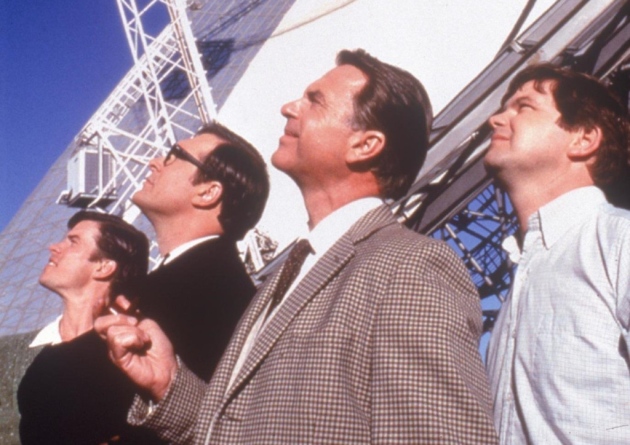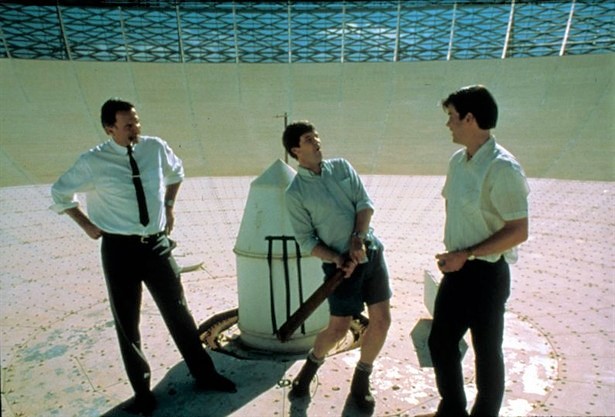
“You treat us like a pack of galahs. [That’s a kind of parrot.] Just because I don't wear a tie or spend all day buried in a manual doesn't mean I'm a drongo. [That’s a hopeless …]”
What’s your favourite line from the movie ‘The Dish’?
Created by Rob Sitch and the Working Dog Productions team, the 2000 film is an Aussie classic. It features Sam Neill, Tom Long and Kev Harrington as staff at our Parkes radio telescope, Murriyang in rural New South Wales, and how they supported receiving and relaying the live TV broadcast images of the Apollo 11 Moon landing.
The Dish is loved by audiences and critics: "David and Margaret" both gave it 4.5 stars! We love the movie so much we thought it’d be fun to take look at what’s fact and what’s fiction, all in the name of a good story, of course.
What’s fact?
1. “We're in the middle of the greatest feat ever attempted. This is science's chance to be daring.”
The Parkes radio telescope, Murriyang did support the Apollo 11 mission. Affectionately known as ‘The Dish’, our telescope tracked Apollo 11 throughout its journey, gathering voice signals from the astronauts, telemetry from the spaceship, and the television signals from the moonwalk itself. It’s true that our help was needed to support NASA’s Honeysuckle Creek and Tidbinbilla facilities near Canberra, and the Carnarvon station in Western Australia. The signals from NASA’s Goldstone, USA, tracking station did "disappear into the ground" on the day. The film also showed a realistic representation of the Parkes control room and how our staff operated the telescope.
2. “What's the bell for?” “Lets us know it's windy.” “I could've told you that. It's blowing a bloody gale.”
Radio telescopes like Parkes can be buffeted by wind just like your umbrella on a windy day. These days the telescope is automatically ‘parked’ at winds of 35km/hr. On the day of the moonwalk it was gusting 100km/hr! And it kept blowing a (bloody) gale throughout the moonwalk! The observatory’s then-Director, John G Bolton, made the decision to keep pointing into the wind. Luckily, it all turned out for the best! Watch former Parkes electrical engineer David Cooke talk about the storm.
3. “They're walking early. Armstrong overruled the sleep break … He said, ‘We don't want to sleep. We want to walk.’”
It’s true, the astronauts did walk ahead of schedule.
And what’s fiction? (To make a good story!)
1. “Honeysuckle Creek, they also have voice and telemetry, yes?”
The movie’s biggest departure from real events is that it gives all credit to the team at the Parkes radio telescope, Murriyang. In reality, the team at NASA’s Honeysuckle Creek tracking station near Canberra as well as other facilities around Australia – including Parkes – all played important roles in supporting the Apollo 11 mission.
The first minutes of the televised broadcast of the Moon landing were received via Honeysuckle Creek, including Neil Armstrong’s iconic ‘One giant leap’ moment. The staff at Honeysuckle also helped to broadcast the historical live television coverage around the world. It was a team Australia effort! And the congratulatory telegram from NASA included many more players than just Parkes.
2. “Still not flat enough, Glenn. I'll give it a tweak.”
Sadly, our staff never played cricket on the Dish. The actors did film this scene on the actual telescope, but they had to be very careful around the equipment and only use a tennis ball. Howzat for a fun film fact?

3. “I thought there's an uninterruptible power source. ” “It was designed as a UPS, but, um, the generator didn't kick back in … ”
We do have a UPS and backup diesel generator, but there was no power failure. All in all, quality control and foresight at Parkes were much greater than the shemozzle shown in the movie. Such was his dedication and thoroughness; Parkes Observatory Director John Bolton actually had his team practice hand cranking the radio telescope to keep the lunar module in range in the event of a total power failure.
4: Young journalist: “Can I have their full names and specific roles?”
The staff names and personas are fictionalised. The real Director, John Bolton, passed away in 1993.
5: “What do I care if some bigwig Yank sees I love my wife?”
There was no animosity with American visitors: we worked together and learned from each other. In fact, in real life there were many more NASA staff present than the one man, ‘Al Burnett’, played by Patrick Warburton in the film: it was a large team effort. Almost 50 years later, we’re still working with NASA, sharing expertise and exploring space together.
6. “Why’s it in the middle of a sheep paddock?!”
The film starts off with the Prime Minister not knowing about Parkes. In fact, the PM knew all about our telescope — half the telescope’s construction funds came from the Australian Government. On the day of the Apollo 11 Moon landing, Prime Minister John Gorton made a surprise visit to Honeysuckle Creek, not Parkes.
7. “It’s as big as a football field.”
Hmm … the dish is big, but not that big. With a diameter of 64 metres, Parkes is one of the largest single-dish telescopes in the southern hemisphere dedicated to astronomy. Don’t believe us? Come and see for yourself!
See The Dish for yourself!
On 20 and 21 July 2019 we celebrated 50 years since the Moon landing with a weekend of open days at the Parkes Observatory.
There were tours of The Dish, talks by Aussie-born NASA astronaut Dr Andrew Thomas, daytime stargazing, roving performers and musicians, face painting, food, astrophotography, and much more. Roy Billing, who played the Parkes Mayor Bob McIntyre in the film (“Elbows, darling”) introduced the open-air screening of The Dish.
These facts were taken from the book "Parkes: 30 Years of Radio Astronomy" available through the Parkes Radio Telescope Visitors Centre.
